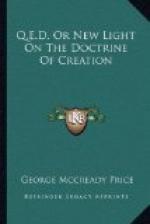As hydrogen is the lightest of the elements, it has been a favorite theory with scientists that the various elements are all composed of combinations of hydrogen atoms. But since many of the elements have atomic weights which cannot be made exact multiples of that of hydrogen, it has been felt that there must be some other smaller unit than the hydrogen atom; or else that these hydrogen atoms themselves change in weight when they combine to form other atoms. But mass seems to be the one unchangeable characteristic of matter; hence it was felt that any change of weight is almost unthinkable, and so a solution was sought in the direction of still further dividing the hydrogen atom, the smallest unit concerned in chemical change, as then understood. But now the facts and principles brought to light in connection with the studies of radioactivity have settled it that we actually do have a much smaller unit than the hydrogen atom, one of only about 1/1760 its mass, in fact; and that this smallest of the small things of nature is none other than a particle of negative electricity, now called an electron.
That the atoms of all the elements must have a common unit of composition, that they behave as if composed of ultimate particles that may be regarded as duplicates of one another, has long been regarded as an inevitable conclusion from the Periodic Law of Mendeleef. This law says that the physical as well as the chemical properties of the various elements depend upon their atomic weights, or as it is stated in the language of mathematics, the properties of an element are functions of its atomic weight. This fact of the variation in the properties of elements in accord with their atomic weights has been even more strikingly illustrated by the behavior of discharges of electricity through rarified gases, as well as by the facts of radioactivity. To quote the words of Sir J.J. Thompson, “The transparency of bodies to Roentgen rays, to cathode rays, to the rays emitted by radioactive substances, the quality of the secondary radiation emitted by the different elements, are all determined by the atomic weight of the element."[1]
[Footnote 1: Encyclopaedia Britannica, Vol. XVII, 891. Cambridge Edition.]
Just recently we have had opened up before us a still more intimate inner-circle view of the composition of matter. H.G.J. Moseley, a young man only twenty-six years of age, at an English university, devised a method of examining the spectra of the various elements by means of the X-rays. He found in this way that the principal lines of these various spectra are connected by a remarkably simple arithmetical relationship; for when the elements are arranged in the order of their atomic weights, they show a graded advance from one to another equal to successive additions of the same electrical unit charge, thus indicating a real gamut of the elements that we can run up by adding or run down by subtracting the same unit of electrical charge. It is pitiable to have to record that next year this scientific genius was killed in the ill-fated Gallipoli expedition against Turkey.




